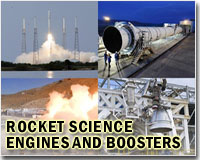 |
Fairbanks AL (SPX) Jan 28, 2011 Scientists from Virginia Tech and the University of Colorado are preparing to launch two NASA sounding rockets for two experiments at Poker Flat Research Range north of Fairbanks. The launch window for both experiments opens on Jan. 26 and extends until Feb. 15. In the experiment set to launch on Jan. 26, if winds are favorable, researchers from the University of Colorado will use a rocket at the top of its arc 200 miles above the ground as a platform to obtain an electronic telescope image of a far-off galaxy. The rocket carrying the second experiment requires similar weather as the first. Scott Bailey, associate professor of electrical and computer engineering at Virginia Tech is the principal investigator of a team that will use a NASA sounding rocket to measure nitric oxide, a molecule that destroys ozone, from about 30 to 100 miles above the ground. That team includes Bill McClintock of the University of Colorado's Laboratory for Atmospheric and Space Physics as well as colleagues from Utah State University's Space Dynamics Lab and Artep Inc. Bailey's team hopes to launch four days after Beasley's Colorado team, possibly Jan. 30 on a night with little to no aurora activity. Instrument scientist Matt Beasley and project scientist Brennan Gantner of the University of Colorado are at Poker Flat preparing to use a 50-foot, two-stage rocket to help capture an image of star-forming regions within the Whirlpool Galaxy. They designed their rocket-mounted instrument to capture an ultraviolet image from just above where the universe goes black. The Whirlpool Galaxy is 31 million light years from Earth. One light year is the distance light travels within one calendar year; one light year equals 6 trillion miles. "No one's ever taken a picture of this wavelength," said Beasley. "The only things that emit at this wavelength are the youngest, hottest stars and accretion disks around black holes." If their experiment is successful, the researchers will obtain an image that they will combine with information from other missions in order to further understand where and how stars form. Unlike in many other Poker Flat rocket missions, the researchers don't need a ripping display of aurora to launch their rocket; they require only darkness and winds that will assure the rocket stages fall to the ground in safe places. In the second experiment, Bailey, who formerly worked at the University of Alaska Fairbanks Geophysical Institute, chose Poker Flat for the study because the energetic electrons within the aurora create nitric oxide while sunlight destroys it. A far-north rocket range in winter allows him to measure what might be the highest concentrations of nitric oxide in the upper atmosphere. "The weather in the stratosphere and mesosphere can pull things from the upper to lower atmosphere," Bailey said. "How much (nitric oxide) is up there to be pulled down? We have an idea of how to measure it." Bailey and his colleagues will use an ultraviolet spectrograph designed by McClintock and mounted on a two-stage rocket to estimate the amount of nitric oxide in the upper atmosphere. They will point the instrument at a star of known brightness. Because the presence of nitric oxide affects the spectrograph's ability to register the starlight, the instrument's readings should allow them to calculate the amount of nitric oxide detected as the payload arcs above northern Alaska. All this will happen during the 15 minutes it will take from the ignition of the first rocket motor to the parachute-softened impact of the rocket payload. "For us, it all comes down to about 100 seconds," Bailey said. Personnel from Poker Flat will retrieve with a helicopter the instruments from both missions. While the public is not permitted on Poker Flat Research Range during rocket launches, people may view rocket launches and activity from several vantage points near the range.
Share This Article With Planet Earth
Related Links Virginia Tech Rocket Science News at Space-Travel.Com
 Japanese rocket puts cargo into orbit
Japanese rocket puts cargo into orbitTokyo (AFP) Jan 22, 2011 A Japanese rocket successfully took an unmanned cargo transporter to the International Space Station into orbit on Saturday, Japan's space agency said. The H-IIB rocket took off from the Tanegashima space centre in southern Japan on schedule at 2:37 pm (0537 GMT). Around 15 minutes later it put the cargo unit into a planned orbit, according to the Japan Aerospace Exploration Agency (JAXA). ... read more |
|
| The content herein, unless otherwise known to be public domain, are Copyright 1995-2010 - SpaceDaily. AFP and UPI Wire Stories are copyright Agence France-Presse and United Press International. ESA Portal Reports are copyright European Space Agency. All NASA sourced material is public domain. Additional copyrights may apply in whole or part to other bona fide parties. Advertising does not imply endorsement,agreement or approval of any opinions, statements or information provided by SpaceDaily on any Web page published or hosted by SpaceDaily. Privacy Statement |